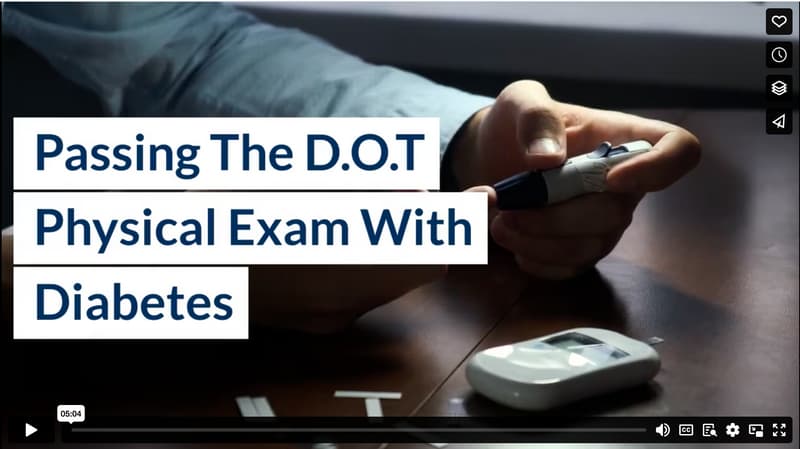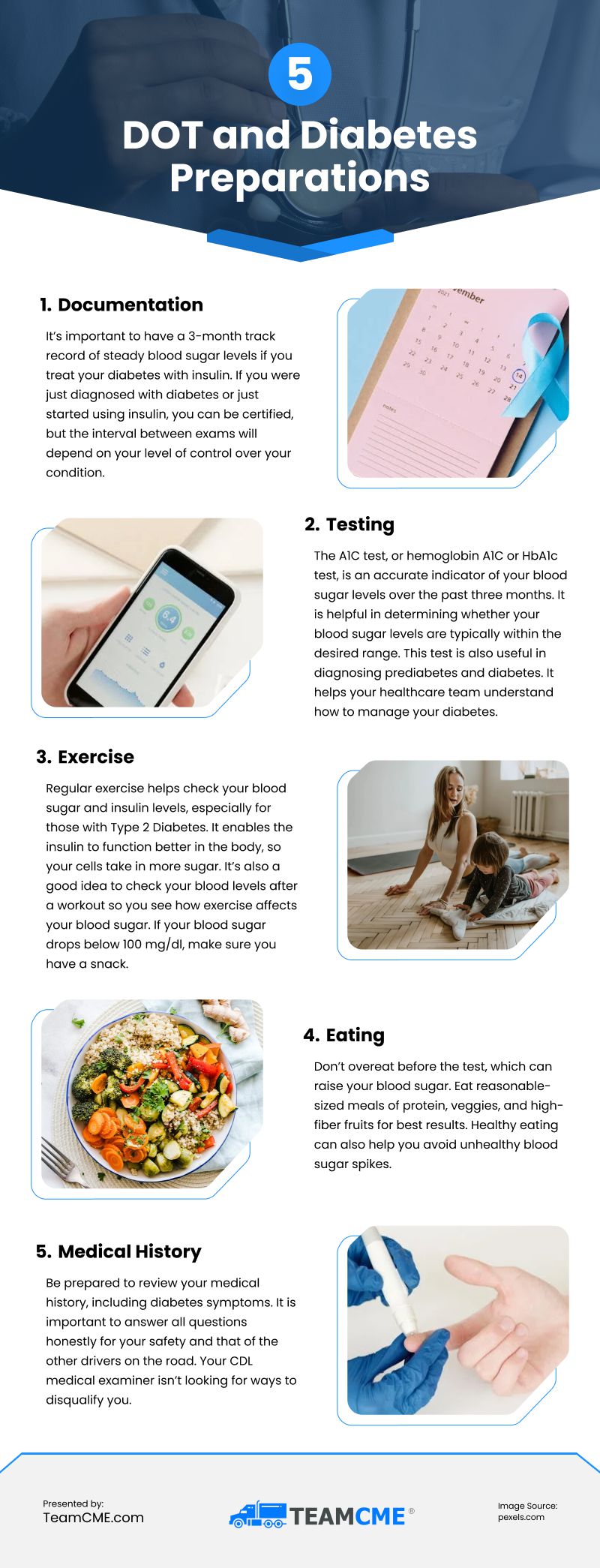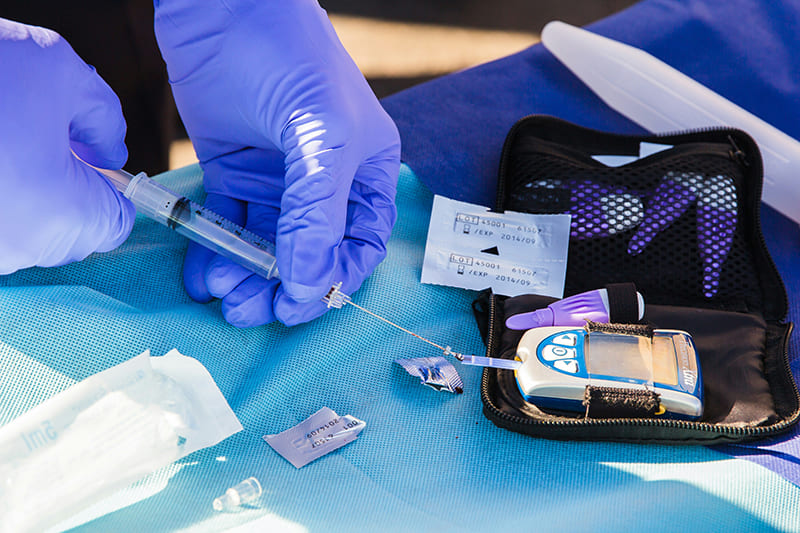Passing The DOT Physical Exam With Diabetes
Diabetes is a complex disease that can make it challenging for you to control your blood sugar levels. Over time, elevated blood sugar levels can cause damage to many organ systems throughout the body. Drivers with diabetes are more likely to develop other health problems as well. If you struggle with diabetes, you may wonder if you can pass the DOT exam. The answer is yes, under certain conditions. First, you should understand the DOT’s concerns to better prepare for your medical exam.
What Is Diabetes?
Our bodies need sugar in the form of glucose to function. When you eat carbohydrates, your body converts them to glucose, which the blood delivers to the cells for use throughout the body. The pancreas secretes a hormone called insulin, which shuttles sugar into the cells for energy. In those with diabetes, not enough of the sugar in the blood gets shuttled into the cells, leaving excess sugar in the bloodstream. The reason behind this problem depends on the type of diabetes.
Type 1 Diabetes: You’re born unable to produce proper amounts of insulin.
Type 2 Diabetes: Lifestyle choices such as poor diet and a lack of exercise lead to metabolic resistance. Your body responds to insulin less over time, resulting in the need for diabetic medications or injectable insulin.
When there is too much sugar in your blood, you can experience the following symptoms:
- Unusual thirst
- Unusual hunger
- Widespread inflammation
- Frequent urination
- Blurred vision
- Dizziness
- Peripheral neuropathy (nerve damage in the extremities)
- Breathing problems
- Vomiting
- Unusual fatigue
- Body aches
- Confusion
If left untreated, uncontrolled blood sugar can lead to:
- Vision impairment
- Heart attack
- Stroke
- Kidney failure
- Slower healing rates (which can end in gangrene in the hands and feet and progressively drastic amputations)
- Seizure Loss of consciousness
- Coma
- Death
Diabetes and the DOT
Diabetes is one of the conditions that could disqualify you if it isn’t managed correctly, which means to operate commercial vehicles you need to have your blood sugar under control. Additionally, you can’t experience symptoms that could make you a danger on the road, like seizures, dizziness, and vision problems, to name a few. If you can prove you are controlling your condition adequately, then you can pass your exam and get your DOT medical card. Drivers with poor or uncontrolled diabetes can be certified, but generally only for three months and they must show improvement on the next exam. The medical card is usually good for one year for those with diabetes.
How to Prepare for the Exam?
Documentation: It’s important to have a 3-month track record of steady blood sugar levels if you treat your diabetes with insulin. If you were just diagnosed with diabetes or just started using insulin, you can be certified, but the interval between exams will depend on your level of control over your condition.
If you treat your diabetes with insulin, please bring the Insulin-Treated Diabetes Mellitus Assessment Form (ITDM Assessment Form). Your doctor must fill out this form, attesting to the fact that your condition is stable and controlled adequately to be safe driving multi-ton vehicles on public roads.
Testing: The A1C test, or hemoglobin A1C or HbA1c test, is an accurate indicator of your blood sugar levels over the past three months. It is helpful in determining whether your blood sugar levels are typically within the desired range. This test is also useful in diagnosing prediabetes and diabetes. It helps your healthcare team understand how to manage your diabetes. When required, you can often get this test taken care of during your examination or you can bring a copy of a recent lab report.
Exercise: Regular exercise helps check your blood sugar and insulin levels, especially for those with Type 2 Diabetes. It enables the insulin to function better in the body, so your cells take in more sugar.
Too much exercise can cause sugar to go too low in those who take regular insulin doses, however. Test your blood sugar before your workout. According to Web MD, it should be between 100 mg/dl and 250 mg/dl. You need a snack if it’s lower than 100 mg/dl.
It’s also a good idea to check your blood levels after a workout so you see how exercise affects your blood sugar. If your blood sugar drops below 100 mg/dl, make sure you have a snack.
Eating: Don’t overeat before the test, which can raise your blood sugar. Eat reasonable-sized meals of protein, veggies, and high-fiber fruits for best results. Healthy eating can also help you avoid unhealthy blood sugar spikes.
Medical History: Be prepared to review your medical history, including diabetes symptoms. It is important to answer all questions honestly for your safety and that of the other drivers on the road. Your CDL medical examiner isn’t looking for ways to disqualify you. Any symptoms that would make you ineligible to drive commercial vehicles are serious and must be addressed before you get behind the wheel. Once your condition is stable, then you can reapply.
Driving With Diabetes
Diabetes can be a severe problem if untreated, but by following your doctor’s instructions, you can manage your condition. If your condition is controlled, you can pass your medical exam and drive commercial motor vehicles safely.
Video

Infographic
To operate commercial vehicles, you need to have your blood sugar under control due to diabetes. If managed correctly, you can pass your exam and get your DOT medical card. Keep reading to learn how to prepare for the DOT exam in this infographic.


